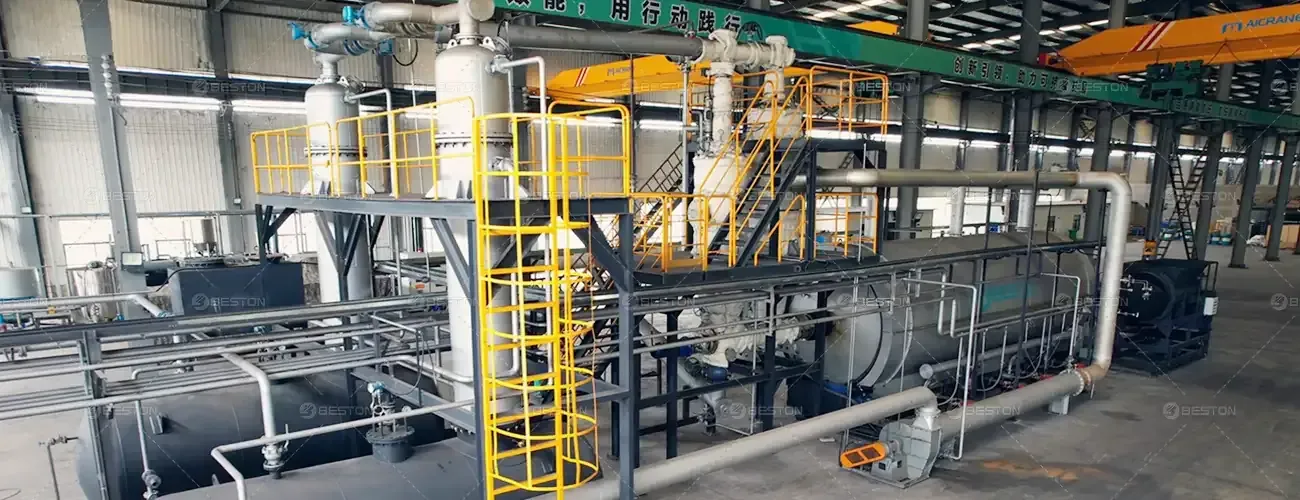Optimizing the Flash Point of Tire-Derived Pyrolysis Oil
The flash point of tire-derived pyrolysis oil is a critical quality parameter influencing storage, transportation, and end-use safety. A low flash point increases volatility, leading to flammability risks and limiting the oil’s acceptance in industrial markets. Optimizing this property requires a comprehensive approach that spans feedstock preparation, thermal process design, and downstream refining.
Influence of Feedstock and Preprocessing
The nature of scrap tire feedstock significantly determines the oil’s volatile fraction composition. Tires with higher proportions of synthetic rubber and additives often generate light hydrocarbons that depress flash point. Preprocessing measures such as shredding and controlled drying help ensure consistent thermal decomposition, while selective removal of non-rubber components minimizes impurities that destabilize oil quality. Uniform feedstock preparation forms the foundation for stable tyre pyrolysis plant outputs.

Process Parameters and Reactor Control
Within a tyre to oil plant, the balance of temperature, residence time, and heating rate defines the oil’s chemical profile. Elevated temperatures above 500°C tend to favor cracking reactions that yield more light hydrocarbons, reducing flash point. Maintaining controlled conditions in the 400–480°C range, with optimized vapor residence times, promotes the formation of heavier fractions with higher stability. Reactor sealing and oxygen exclusion are essential to prevent partial combustion, which can both degrade oil quality and introduce unpredictable volatiles.
Catalytic Influence on Hydrocarbon Distribution
Catalysts offer a powerful means of steering product composition toward heavier, less volatile fractions. Zeolite-based catalysts, for example, can rearrange hydrocarbon chains and suppress the generation of excessive light olefins. Metal-supported catalysts introduce secondary reforming pathways, enhancing aromatic stabilization and raising flash point. However, careful selection is required to balance catalytic performance with operational cost and regeneration demands.
Fractional Condensation and Separation
Condensation systems directly affect the volatility of the recovered oil. Multi-stage condensers, designed to sequentially cool vapors at different temperature zones, allow controlled separation of light and heavy fractions. By diverting the lighter condensates for further refining and retaining the heavier oil streams, overall flash point can be substantially improved. Effective condensation also minimizes contamination from water vapor and particulate matter, both of which compromise stability.
Post-Treatment and Upgrading Techniques
Downstream upgrading processes provide additional opportunities for flash point optimization. Distillation is a widely used method, enabling the removal of low-boiling components and yielding a refined fuel fraction with higher flash point. Hydrotreatment, though capital-intensive, hydrogenates unstable compounds and reduces unsaturated hydrocarbons, resulting in enhanced thermal stability. Blending pyrolysis oil with higher-flash-point industrial fuel can also elevate final specifications for commercial applications.
Storage and Handling Considerations
Even after optimization, improper handling can diminish oil safety. Exposure to high ambient temperatures or prolonged storage without stabilization may lead to volatilization and gradual flash point reduction. Storage in sealed, inerted tanks with controlled temperature conditions ensures preservation of fuel quality. Incorporating antioxidant additives during storage further delays degradation and sustains desirable flash point levels.
Market Relevance of Flash Point Enhancement
Industrial buyers prioritize consistent fuel properties to meet safety and regulatory standards. A pyrolysis oil with a flash point above 60°C gains wider acceptance in boiler and furnace applications, while low-flash-point fractions are often relegated to less lucrative markets. Optimizing this property not only enhances marketability but also positions pyrolysis plant operators to meet evolving compliance requirements in fuel trading and transportation.



